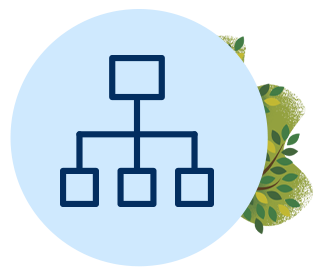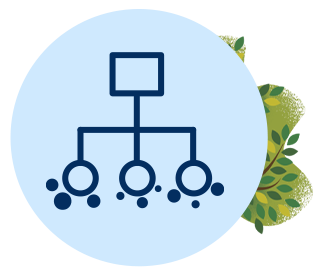Assess Your Business
Learning Objectives
After completing this unit, you’ll be able to:
- Explain how business goals affect your organizational structure.
- Define ownership and authority, and explain why they are important.
- Identify which organizational model works best for your business.
Ecommerce Isn’t One-Size-Fits-All
Every brand and organization is unique. Some are geographically specific and managed by one central team, and others are sprawling, multibrand enterprises that operate all over the world. These variations in size and region are only the tip of the iceberg when it comes to the many factors that determine how a brand operates with ecommerce. In this module, you learn key considerations that help commerce leaders and decision makers structure their businesses and teams for success.
It all begins with an honest assessment of your organization and your goals. A good understanding of how your business is currently structured (and how you envision it in the future) should guide your implementation.
How Scaling and Expanding Affect Your Organizational Structure
When assessing your ecommerce goals, consider how they will affect your business structure in the long-term. As you plan your digital transformation and envision the future, ask yourself these key questions.
- How many brands do you have? If you have goals to add new brands to your portfolio, consider whether each separate business unit will operate independently—and how much autonomy each will have. If you want clear cohesion between multiple brands, you need to establish guidelines and best practices—then implement a system to ensure all business units follow suit.
- How mature is your organization when it comes to digital initiatives? Scaling your business undoubtedly involves building new ecommerce capabilities and features over time. Determine whether your in-house team will take charge of these new digital experiences or if you need to bring in a partner to assist.
- Do you have goals to expand to more geographies? International aspirations can have an enormous impact on your teams. If you operate in diverse geographies, you need to translate your site into new languages, follow the data and privacy regulations of each region, collaborate on operational changes, and more.
Once you’ve thought through your goals and determined what growth looks like for your business, the next step is to establish ownership and authority.
Establish Digital-First Leadership Roles
Before setting out on your ecommerce journey, you need to establish all the rules, relationships, systems, and processes that define responsibility within your company.
Consider this scenario: Cloud Kicks, a company that specializes in high-end custom sneakers, wants to launch a new brand for kids. Who will be in charge of the roadmap for this new ecommerce experience? Will the business bring in a new team to launch the brand and manage it once it’s up and running? With well-defined roles, the company can plan the new implementation with maximum clarity about responsibilities and accountability.
Establishing clear ownership helps you lay a solid foundation for management and oversight of your businesses and teams. It creates structure and clarity to help guide each individual team to work within the framework provided. Ultimately, governance defines ownership, enables faster growth, and allows your teams to operate more productively.
The Four Operating Models
While ownership and responsibilities define the oversight within a company, operating models help provide even more structure. These models establish the roles and reporting structure within a business and ensure that the structure supports business goals. If you think of ownership as the basic outline of a business, operating models are the final draft. Typically, businesses operating ecommerce fall into one of four categories: a centralized model, a distributed model, a center of excellence, or a hybrid model. Let’s review each one, along with their pros and cons.
Centralized Model
The centralized model works best with one dedicated team coordinating all digital activities—like merchandising, marketing, SEO, analytics, and development—across business units. Most smaller ecommerce businesses deploy this model. For example, single-brand direct-to-consumer (D2C) start-ups can deploy a centralized model to easily launch ecommerce early in their digital maturity.

Pros and cons of a centralized model:
✔️ A singular, focused team with a clear vision
✖️ Difficult to scale if and when you expand to new geographies or add new brands
Distributed Model
With a distributed model, each business unit typically leads their own digital change and is only accountable for their own initiatives. Consider a large holding company with several distinctly different brands under one portfolio. With a distributed model, each brand can operate independently and each site can be managed separately—with no need for consistency in terms of UX design, features and functionality, and integrations.

Pros and cons of a distributed model:
✔️ Offers freedom for businesses with a diverse range of brands and geographies
✖️ May be difficult for brands that want a cohesive strategy across business units
Center of Excellence
The center of excellence is typically a core team of digital specialists who test, deploy, and manage technologies—with marketing frequently at the forefront. This team's main focus is to create guidelines and best practices for all lines of business within the organization. The goal is to improve the customer experience and use digital strategies to gain a competitive advantage.

Pros and cons of a center of excellence model:
✔️ Offers continuity for a diverse range of brands and geographies
✖️ Mandates cohesion across business units, which can hinder brand autonomy
Hybrid Model
A hybrid approach takes the brand autonomy of the distributed model and combines it with the oversight and general guidance of a center of excellence. This creates an organizational structure that allows separate brands to have distinctive, exclusive experiences while adhering to best practices set by a centralized team of experts.

Pros and cons of a hybrid model:
✔️ Brands have strategic guidance but are still able to maintain autonomy
✖️ Potential for friction and costly overhead if brands don’t adopt recommendations
Next Steps
Congrats! You’ve assessed your business structure and determined which organizational model works best for you. Next, explore the key roles and activities necessary for ecommerce success.